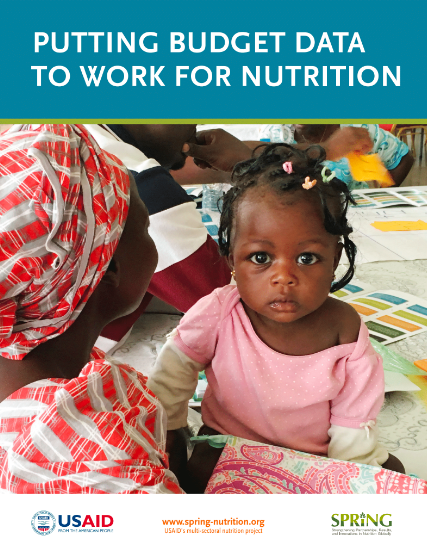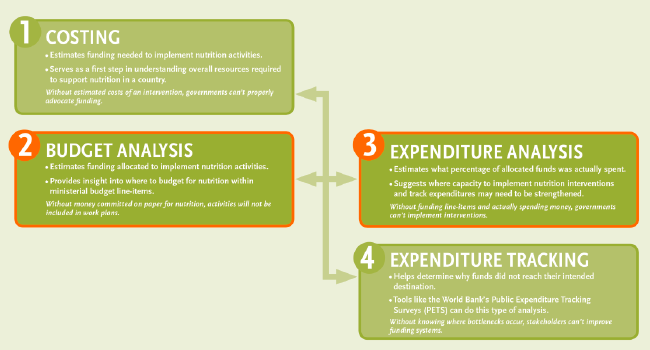Putting budget data to work for nutrition
Summary of research1
Location: Global
What we know: There is a major global funding shortfall to meet malnutrition targets; accurate data on national nutrition budgets and spend is needed to inform decision-making and support accountability.
What this article adds: SPRING interviewed 25 key decision-makers in 11 countries to examine how budget data are currently used for decision-making at country level. Findings showed that data are used to identify and coordinate nutrition across sectors, advocate for more nutrition funding and track and manage use of funds. Analyses should be adapted to fit the country’s needs involving an iterative, evolving and ideally regular and routine process. A range of stakeholders should be included to increase buy-in and findings should be targeted to specific audiences. Progress is being made at country level to analyse and nutrition budget and spending; however, it is essential that findings are shared with decision-makers and that they clearly identify gaps in spending and include district-level data to ensure that funding matches needs and translates into implementation.
 Many actors have come together under the auspices of the Scaling Up Nutrition (SUN) Movement, the Millennium and Sustainable Development Goals (MDGs and SDGs) and other frameworks to address malnutrition. Achieving results requires adequate funding; however, estimates from the World Bank’s Investing in Nutrition report suggest that the global community is seven billion dollars short of the funding necessary. Until recently, few nutrition actors could specify how much funding was allocated to nutrition. The lack of data on national nutrition budgets and spend meant that governments and implementing partners did not have accurate, up-to-date information on how nutrition was being prioritised or how well countries were spending their nutrition funds. The SUN Movement, along with several donor-funded nutrition projects, have released guidance to help countries collect budget data and make an investment case. By the end of 2017, nearly 50 countries had analysed how much money had been budgeted for and some had gone further to track actual nutrition spending (Figure 1). To support this effort, SPRING gathered information and interviewed 25 key decision-makers in 11 countries, from ministry staff to local non-governmental organisations (NGOs), to learn more about country-level experiences using budget data for decision-making. These experiences were synthesised around three main questions.
Many actors have come together under the auspices of the Scaling Up Nutrition (SUN) Movement, the Millennium and Sustainable Development Goals (MDGs and SDGs) and other frameworks to address malnutrition. Achieving results requires adequate funding; however, estimates from the World Bank’s Investing in Nutrition report suggest that the global community is seven billion dollars short of the funding necessary. Until recently, few nutrition actors could specify how much funding was allocated to nutrition. The lack of data on national nutrition budgets and spend meant that governments and implementing partners did not have accurate, up-to-date information on how nutrition was being prioritised or how well countries were spending their nutrition funds. The SUN Movement, along with several donor-funded nutrition projects, have released guidance to help countries collect budget data and make an investment case. By the end of 2017, nearly 50 countries had analysed how much money had been budgeted for and some had gone further to track actual nutrition spending (Figure 1). To support this effort, SPRING gathered information and interviewed 25 key decision-makers in 11 countries, from ministry staff to local non-governmental organisations (NGOs), to learn more about country-level experiences using budget data for decision-making. These experiences were synthesised around three main questions.
Figure 1: What is nutrition budget and expenditure analysis?

How are findings from nutrition budget and expenditure analysis used?
First, nutrition budget and expenditure analysis served to identify and coordinate nutrition across sectors. By following the flow of funding, budget analysis helped to identify stakeholders not traditionally considered as having a nutrition interest. Working together to collect, analyse and review budget information also brought relevant stakeholders together and strengthened coordination structures.
Second, nutrition budget and expenditure analysis provided opportunity to advocate for more funding for nutrition. The process highlighted funding gaps and shortfalls in financial commitments and enabled comparison of spending with the amount being lost to poor nutrition, making a compelling case for increased nutrition funding. Seven out of 11 countries interviewed said that budget and/or expenditure data were useful for making an advocacy case for nutrition.
Third, nutrition budget and expenditure analysis was used to track and manage the use of nutrition funding. In some cases, a routine reporting system was instituted to allow the transparent tracking of resources, ensure commitments were fulfilled and verify that funding was used effectively.
What lessons have countries learned about using nutrition budget analysis data?
Nutrition budget and expenditure analysis is a new initiative in many countries and many participants in the review shared lessons learned so far in the process, including:
There is no one “right way” to use the data from nutrition budget and expenditure analysis –data use should fit the country’s needs. Several ways have been highlighted, as set out above, but many other uses for nutrition budget and expenditure analysis exist, depending on how policy is made, how budgets and expenditures are finalised, the reasons for the analysis and which stakeholders are involved.
Financial analysis is often an iterative, evolving process and the availability and use of data often improves with each subsequent round of analysis. Countries reported that regular data would be more effective for changing policy and influencing budgets over the longer term.
Knowing when to use your findings is an important part of the process. Budget and expenditure analysis is most effective for planning and advocacy when it is timed so that the results can be shared with decision-makers while the budgeting process is ongoing.
Involving a range of stakeholders in budget analysis and dissemination broadens perspectives and increases buy-in and use of findings. Although the budget analysis itself is often limited to a small group of stakeholders, sharing and discussing the findings is a chance to involve a wide range of actors, ensure that all data sources are used and engage civil society partners early in the process.
Target the dissemination of findings, using language and evidence appropriate for each audience. Initially, the goal of sharing analysis findings may simply be to raise awareness of the need for more detailed data about nutrition funding. There is a need to strengthen or disaggregate existing resource-tracking systems to allow for more accurate analyses in the future.
Consider adopting systems to make monitoring and tracking routine. Nutrition budget data can rarely be found within routine information or tracking systems, which slows the process and means that financial information cannot easily be linked to other routine nutrition monitoring data. Developing a system for nutrition resource-tracking can greatly facilitate the process of reporting, collecting, analysing and using nutrition budget and expenditure data.
How can we improve use of data from nutrition budget and expenditure?
Budget and expenditure analysis can only affect funding allocations and expenditures for nutrition if the findings are used and convincingly shared with decision-makers. Estimates of nutrition funding and expenditures can have wide margins of error and often are not comparable to the estimated costs of activities. This makes it difficult to clearly define gaps in spending, which is needed to make a case for investing in nutrition. In addition, a lack of information on district-level budgets and expenditures makes it challenging to determine if funding and/or expenditures match local needs or translates into implementation. Nonetheless, these early estimates are a huge step forward in planning and advocating for nutrition funding and provide essential building blocks for future analysis of planned and actual nutrition spending.
Endnote
1SPRING. 2018. Putting Budget Data to Work for Nutrition. Arlington, VA: Strengthening Partnerships, Results, and Innovations in Nutrition Globally (SPRING) project.

